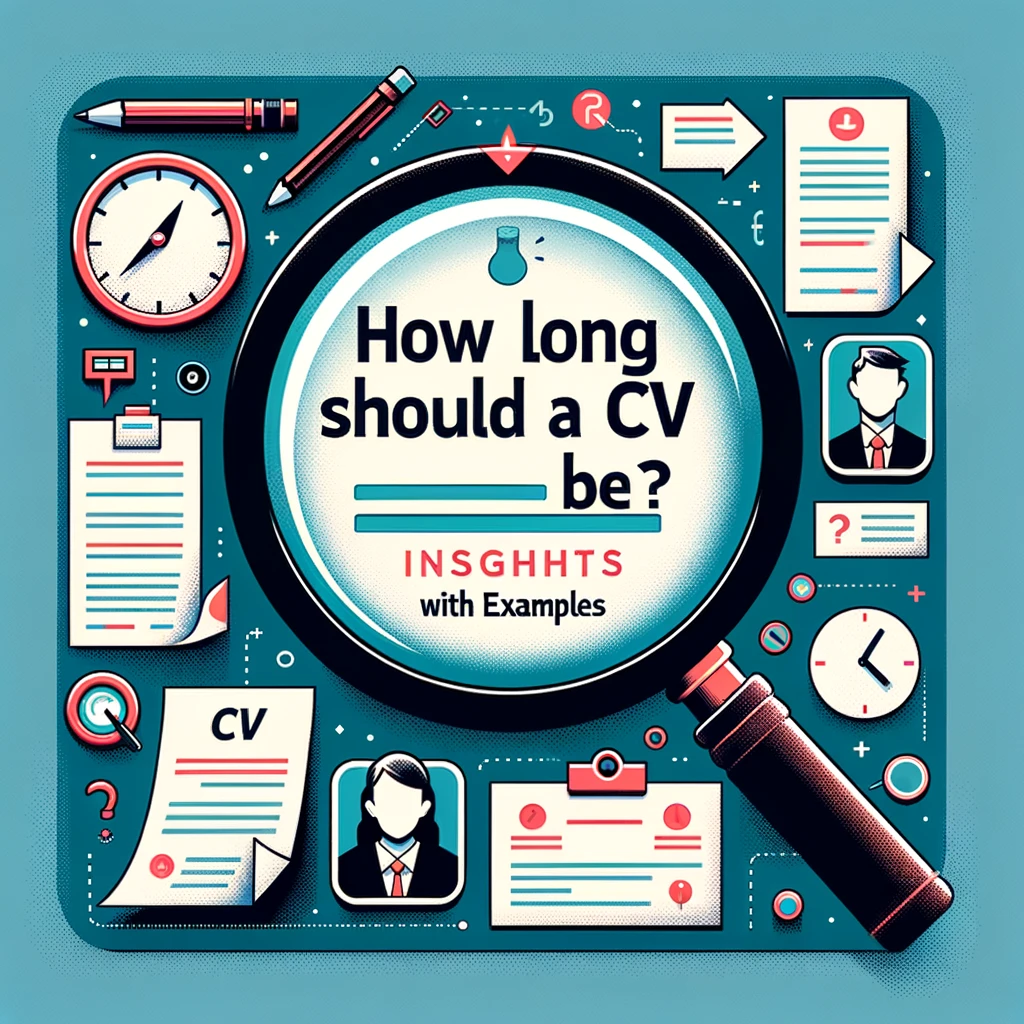How Long Should a CV Be? Insights with Examples
Introduction
Navigating the complexities of crafting the perfect CV can often feel like an art form. A common question that arises is, “How long should a CV be?” The answer is not one-size-fits-all; it varies based on several factors, including industry norms, career stage, and the specific job you’re applying for. This blog dives deep into the nuances of CV length, offering guidance to ensure your CV not only showcases your achievements but also aligns with recruiters’ expectations.
Ideal CV Length by Career Stage
Entry-Level Positions:
For individuals just stepping into the workforce, a one-page CV typically suffices. This stage of your career is likely characterized by education, internships, and possibly some relevant project work or skills that directly apply to the job you’re aiming for. The key here is to focus on quality over quantity, presenting a concise overview of your academic achievements, any practical experience gained through internships or part-time roles, and skills that are pertinent to the job. Highlighting coursework, projects, and extracurricular activities that demonstrate relevant skills and competencies can make a strong impression.
Mid-Level Professionals:
As you accumulate a few years of professional experience, expanding your CV to two pages allows you the space to detail your professional journey comprehensively. This is your opportunity to outline significant roles you’ve held, projects you’ve contributed to, and key achievements in your career thus far. It’s also a chance to showcase the evolution of your skills and how they’ve contributed to your professional growth and the success of your employers. Emphasize roles and responsibilities, highlighting any leadership positions or initiatives you’ve led, and detail the impact of your work through quantifiable achievements.
Senior-Level Executives:
For those with extensive experience, particularly in leadership roles, a CV that extends up to three pages can be appropriate. This length is justified by the need to detail a lengthy career with significant achievements, leadership positions, strategic initiatives you’ve directed, and the tangible impact of your work on your organizations. It’s important to present a narrative that not only chronicles your career progression but also underscores your strategic vision, leadership philosophy, and the cumulative impact of your contributions.
Factors Influencing CV Length
Skills and Experience:
The depth and breadth of your skills and professional experiences play a crucial role in determining the necessary length of your CV. Specialized fields often require a detailed presentation of skills and experiences to adequately convey your qualifications and readiness for complex roles.
Academic Background:
Individuals with rich academic backgrounds, including multiple degrees, certifications, or significant academic honors, might need additional space to fully list these credentials. This is particularly relevant for careers in academia, research, or fields where educational qualifications are heavily weighted.
Professional Achievements:
Significant professional milestones, such as leading high-impact projects, earning industry awards, or achieving notable successes, deserve emphasis and might extend your CV’s length. These achievements provide concrete evidence of your capabilities and potential value to prospective employers.
Publications and Presentations:
For roles emphasizing thought leadership or research, detailing relevant publications, research papers, or presentations is crucial. This not only highlights your expertise and contributions to your field but also positions you as a knowledgeable and active participant in your professional community.
How to Optimize CV Length
Tailoring Your CV:
Adapting your CV for each application is vital. This means emphasizing the experiences and skills most relevant to the job at hand, which can sometimes allow for a more concise presentation without sacrificing the depth of your qualifications.
Prioritizing Content:
Focus on including content that demonstrates the impact and value you’ve brought to previous roles. Utilizing quantifiable results and achievements can convey your contributions effectively, often allowing for brevity by focusing on what matters most.
Formatting Tips for Brevity:
Employ bullet points, concise language, and strategic use of formatting to make your CV as lean as possible while still conveying your qualifications effectively. This includes utilizing fonts, spacing, and layout to enhance readability and conciseness.

Common Mistakes to Avoid
Overloading with Information:
Avoid the temptation to detail every aspect of your career. Concentrate on the elements most relevant to the positions you’re targeting, ensuring your CV is focused and impactful.
Neglecting White Space:
A visually cluttered CV can detract from its content. Ensure adequate white space to facilitate ease of reading and to make your CV more appealing at a glance.
Irrelevant Details:
Exclude personal interests and unrelated work experiences unless they directly contribute to your candidacy for the specific role you’re applying for. This helps keep the focus on your qualifications.
The Role of Design in CV Length
Choosing the Right Template:
Select a template that effectively balances text and design elements, accommodating your content while maintaining readability and visual appeal. The right template can help you make the most of the space available, allowing you to include more information without compromising on design or readability.
Visual Elements and Layout:
Smart use of design elements like infographics or charts can present data or achievements in a more compact form, reducing the need for lengthy textual explanations and adding a visual dimension to your CV that can make it stand out.
CV Length in Different Industries
Industry norms can significantly influence the expected length and detail of a CV. Academic and research positions often require comprehensive detailing of publications, teaching experience, and academic contributions, necessitating a longer CV. Conversely, creative industries might prioritize portfolios and concise CVs that highlight relevant experience and creative skills succinctly.
Adjusting CV Length for Online Applications
Optimizing your CV for online applications, including keyword optimization for ATS systems, is crucial. This might involve careful editing to include relevant keywords without unnecessarily extending the CV’s length, ensuring you meet the criteria for both automated systems and human reviewers.
The Debate: CV vs. Resume
Understanding the distinction between a CV and a resume is crucial. A CV is more detailed and is typically used in academic, education, or research positions. It includes a comprehensive list of one’s education, academic background, teaching experience, publications, awards, and other significant accomplishments. A resume, on the other hand, is a concise document used for job applications outside of those fields, focusing on relevant work experience and skills tailored to the job you’re applying for.
Expert Opinions on CV Length
Hiring managers and career coaches often stress the importance of conciseness and relevance. A well-tailored CV that clearly highlights your most significant achievements and qualifications can be more impactful than one that merely lists every detail of your career history.
How to Trim Down a Long CV
If you find your CV is too lengthy, focus on eliminating redundancies, condensing information where possible, and emphasizing only those experiences and achievements most relevant to your career goals and the positions you’re applying for.
Using Appendices and Portfolios
In some fields, it’s appropriate to include supplementary materials such as a portfolio of work or an appendix listing publications. This approach can allow you to keep the main body of your CV concise while still providing detailed insight into your work and achievements.

Conclusion
The ideal CV length is a balance between providing enough detail to showcase your qualifications and keeping it concise enough to retain the reader’s interest. Tailoring your CV to each application, prioritizing relevant information, and using design elements wisely can help you strike this balance.
FAQs
- How does the ideal CV length change with experience?
The ideal CV length changes with experience because as you progress through your career, you accumulate more experiences, skills, and achievements that are relevant to the positions you’re targeting. For entry-level candidates, a one-page CV is typically sufficient, as the focus should be on education, internships, and any relevant skills or projects. Mid-level professionals, who have a few years of experience, might extend their CV to two pages to detail their professional journey, key roles, achievements, and developed skills. Senior-level executives or those with extensive experience in their field can justify a three-page CV if it’s filled with relevant information that showcases their career progression, leadership roles, and significant achievements that align with the job they’re applying for.
2. Is a three-page CV ever acceptable?
Yes, a three-page CV can be acceptable, especially for senior-level positions or for individuals in fields that require extensive documentation of their work, such as academics, researchers, or high-level executives. The key is relevance and value to the potential employer; every piece of information included should contribute to a picture of you as the ideal candidate for the position. If your career history and professional achievements can fill three pages with pertinent, compelling content that a hiring manager would find relevant and impressive, then a three-page CV is perfectly acceptable.
3.How can I make my CV stand out without adding length?
Making your CV stand out without adding length involves focusing on quality over quantity. Use bullet points to concisely highlight your achievements, utilizing strong action verbs to start each point. Tailor your CV to each job application, emphasizing the experiences and skills most relevant to the job. Including specific, quantifiable achievements (e.g., increased sales by 20%) can make a big impact. Additionally, optimizing the format and design of your CV to ensure it is clean, professional, and easy to read can make it stand out. Leveraging design elements such as bold headings, strategic use of color for emphasis (without overdoing it), and ensuring there is plenty of white space can draw the reader’s attention to the most important information.
4. What’s the difference between a CV and a resume?
The difference between a CV (Curriculum Vitae) and a resume lies in their length, layout, and purpose. A CV is a detailed document that outlines your entire academic and professional history, often used for positions in academia, education, science, or research. It can include a comprehensive list of your publications, presentations, teaching experience, awards, and other scholarly achievements, and it has no length limit. A resume, on the other hand, is a concise document typically limited to one or two pages, tailored for a specific job, highlighting relevant work experience, skills, and education. Resumes are more commonly used in the business, industry, and nonprofit sectors.
5. How should I include publications in my CV?
Including publications in your CV should be done in a manner that highlights your contributions to your field, especially if they’re relevant to the job you’re applying for. Create a separate section titled “Publications” and list your works in reverse chronological order, starting with the most recent. Use a consistent citation style (e.g., APA, MLA) and include co-authors if applicable. If you have an extensive list of publications, consider including only the most relevant or prestigious ones, or those directly related to the job.
6. Can design elements help reduce the perceived length
Yes, design elements can help reduce the perceived length of your CV by organizing information more efficiently and making the document easier and more engaging to read. Using headers to clearly delineate sections, bullet points to list achievements, and fonts and spacing wisely can make a longer CV feel less daunting. Visual elements like charts or infographics can summarize lengthy achievements or skills sets concisely. However, it’s important to use design elements judiciously and ensure that your CV remains professional and readable, with a clear hierarchy of information that guides the reader through your career narrative effectively.
🔴Do you have an ATS (Automatic tracking system) Compliant CV?
🔴Do you have a CV which is globally acceptable?
🔴Do you have professional content in your CV?
✅Get your CV designed and developed today !! Professionally .
Get your Resume reviewed for free by industry experts: Click


![How to Write a Cover Letter That Gets an Interview Call [With Templates]](https://prosumely.com/wp-content/uploads/2024/01/DALL·E-2024-01-13-12.20.43-A-creative-and-professional-cover-image-for-a-blog-titled-How-to-write-a-cover-letter-that-gets-an-interview-call-With-Templates.-The-image-should-768x768.png)




